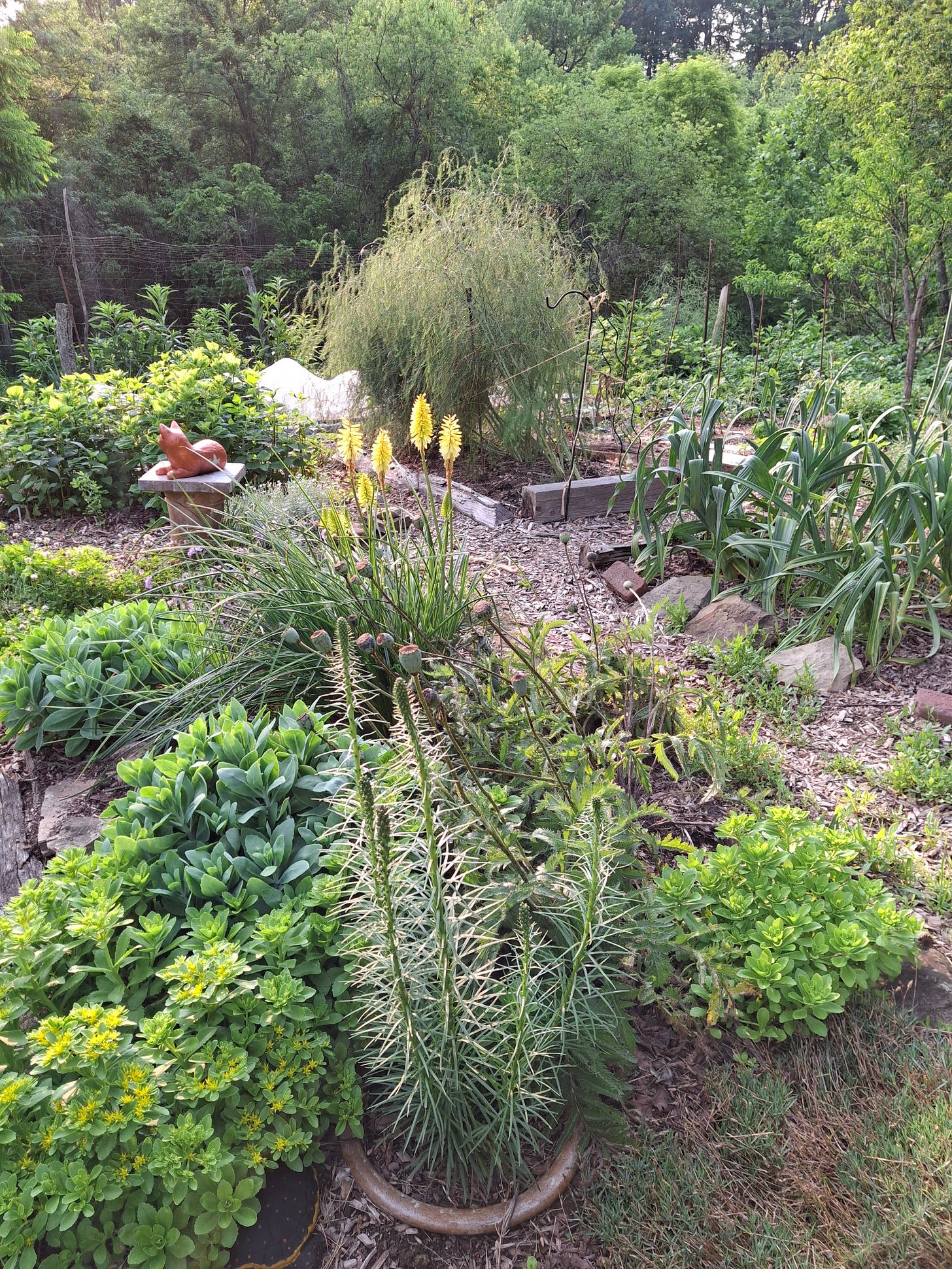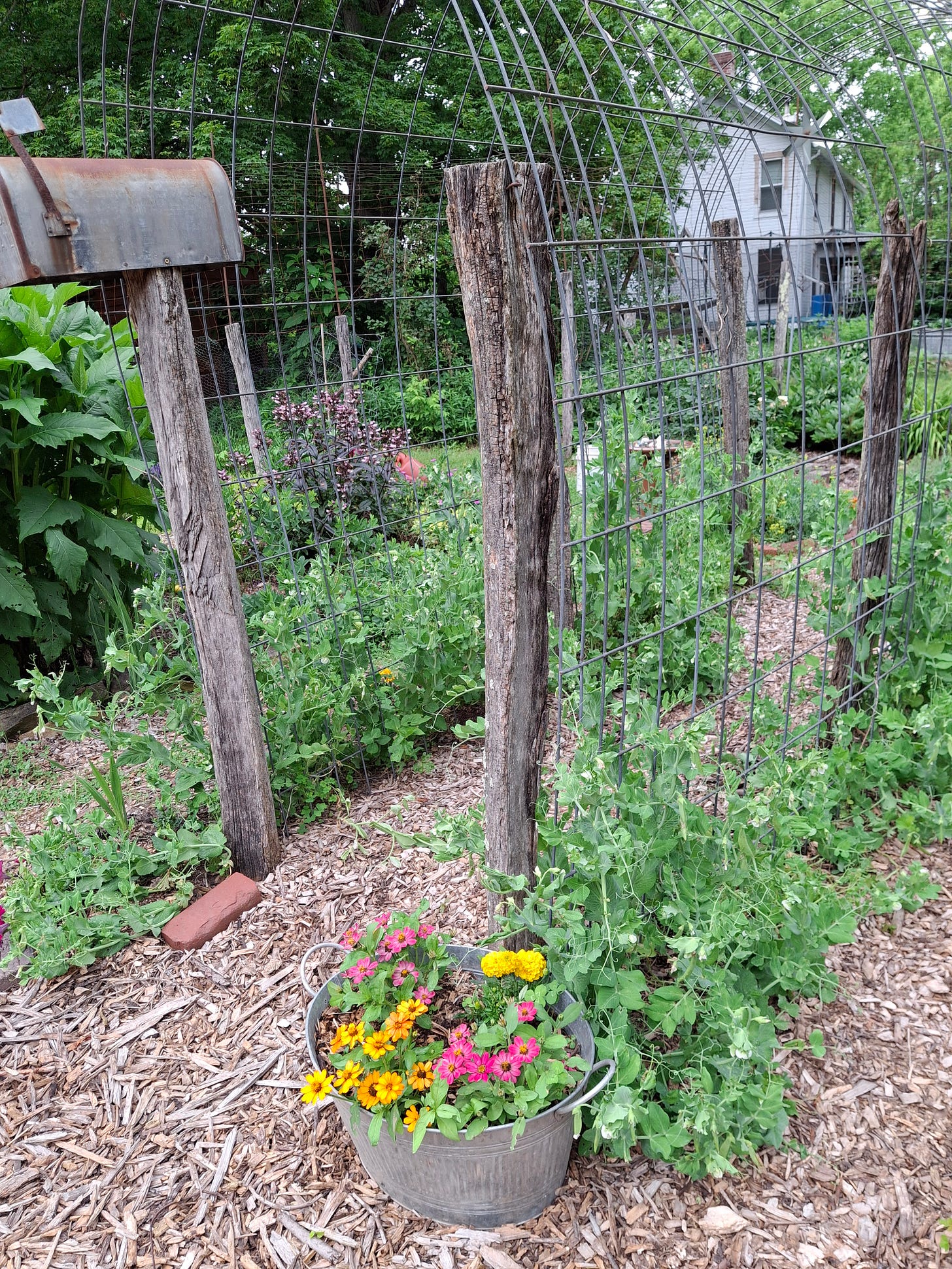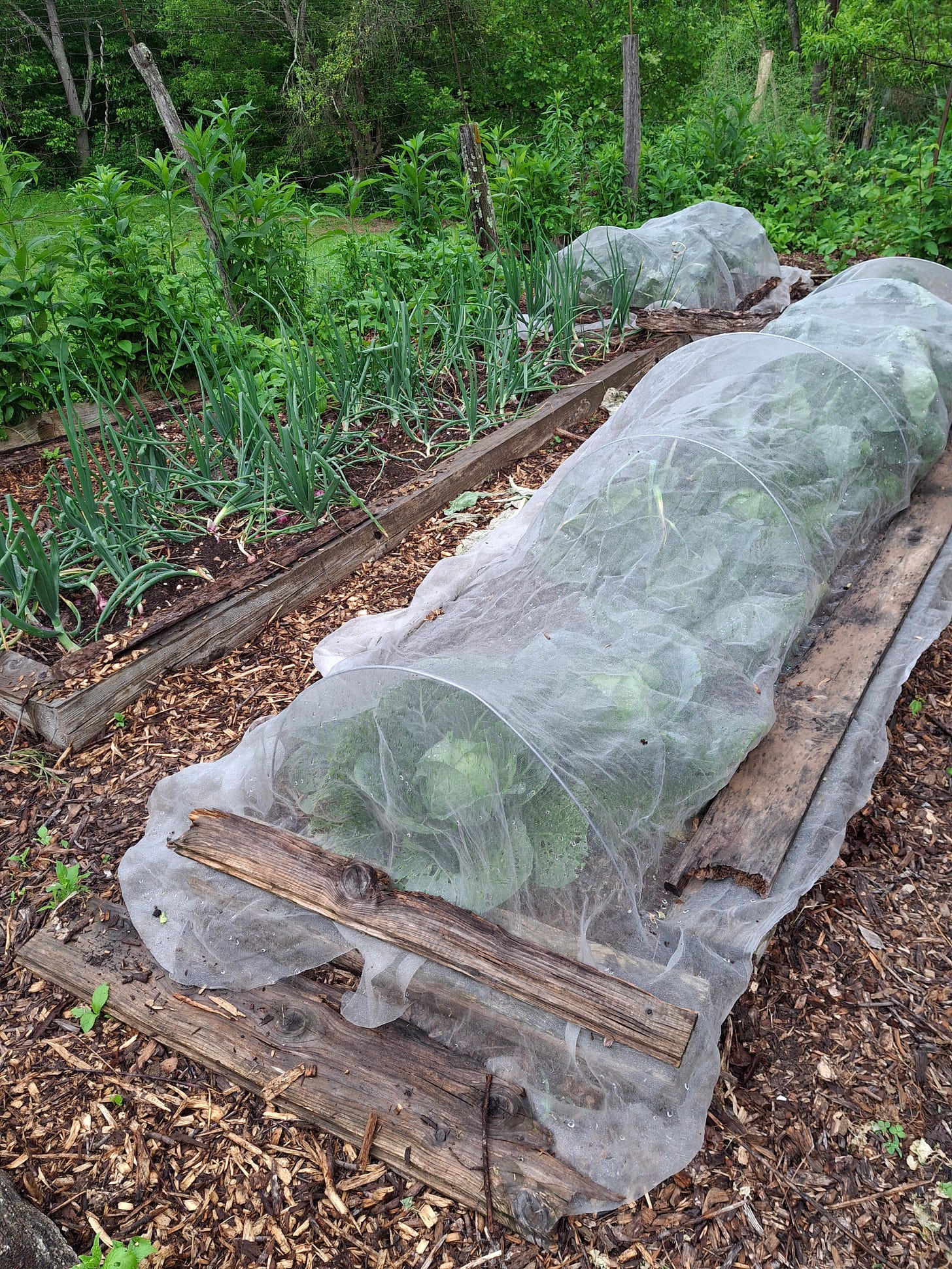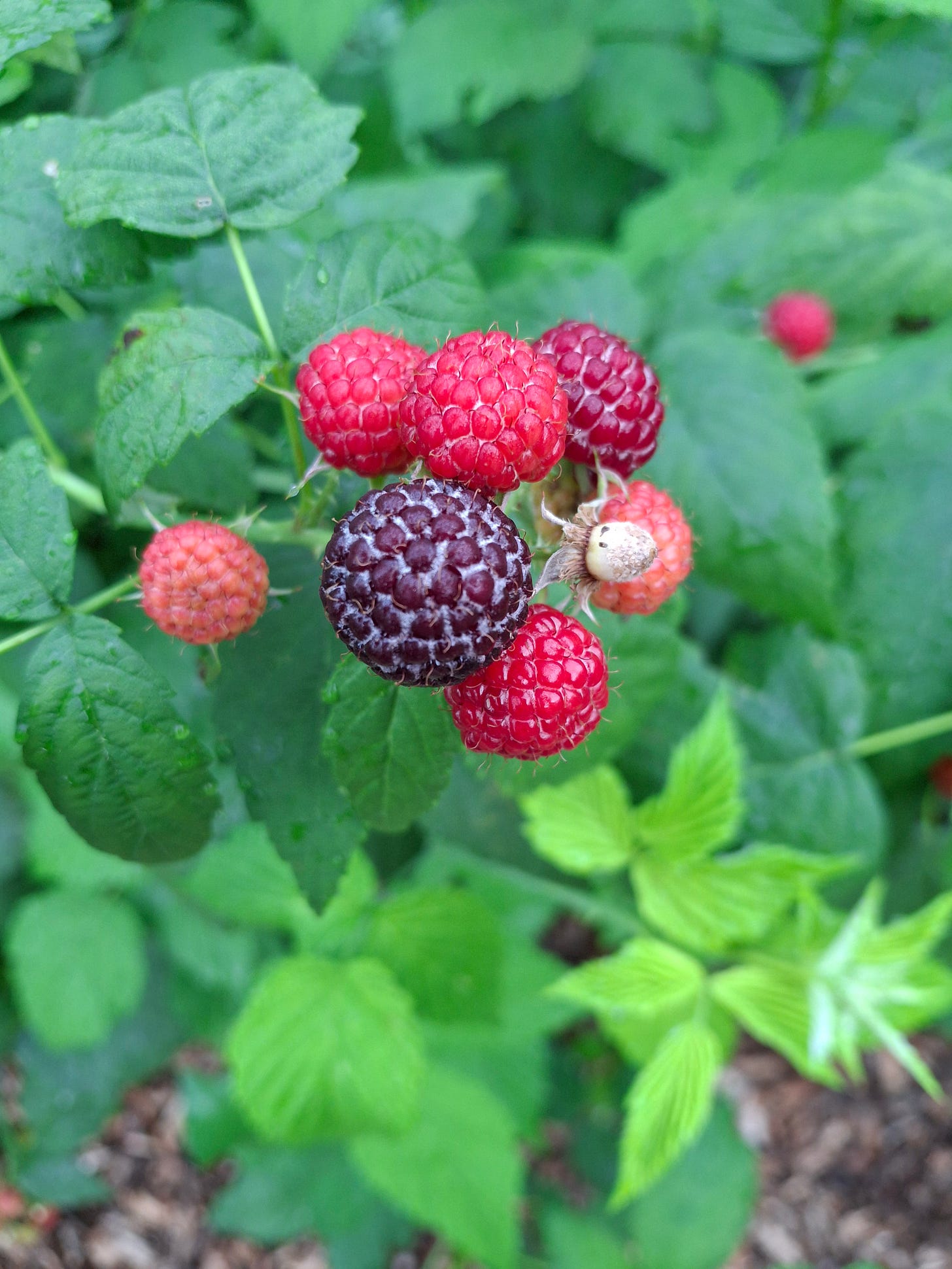If it doesn't work, it doesn't stay
Developing a garden the natural way
Texture is important
The new gardener is faced with the daunting task of how to begin. Whether the starting point is an island bed, a foundation planting, or a mixed potager like mine, having some sort of plan in place before planting saves time and labor. This is easy advice to give out, but to be honest I have a history of simply cramming in plants willy-nilly.
My approach is useful because it allows me to observe and learn a plant’s traits. How close can these plants be without developing fungal problems? Will two plants coexist peacefully or will one overrun the other? What can plants in such and such a grouping offer as benefits to each other?
I end up having to move plants often as I learn the answers to these questions. For me, slow and steady wins the race in garden design. My method takes longer than simply figuring out a plan that looks good on paper, then planting, but results in arrangements that are far superior in the long term because they have proven themselves to work.
French horticultural beans in straight rows contrast with a wild corner
When it comes to how my garden has developed, it is helpful to understand evolution as an analogy. As species evolve there is no plan, no result that nature is striving for, no end point. Things happen: random mutations, ice ages, meteor strikes. The world changes but the ongoing process of evolution remains constant and always follows an inexorable logic — if it doesn't work, it doesn't stay.
This is how I view the process of garden development over the last quarter century. The fact that there was never a plan that I was working toward has given me great freedom. Rather than meteor strikes or ice ages, the garden has experienced insect attacks and harsh winters. Sometimes weather or bugs gets to decide what works and what doesn't, but I participate in the process also. I yank plants for composting, move them to new locations, prune then heavily, or do nothing, based on what works. Bitter disagreements between Mother Nature and me are quite common. For example, I disapprove of her plan to fill the garden with wingstem and violets. While this attempt is necessarily met with a hard no, I pay attention to what is happening and take suggestions when appropriate.
The development of the garden might look like a never-ending struggle for control of territory, but it's better viewed as an ongoing negotiation. I constantly push limits to learn what works. One arena of continuing experimentation is determining how much shade plants can take and still thrive. Sunny space is limited inside the garden fence, but there is shaded space that could be better used. I've gradually discovered plants that can thrive on the shady margin; those that don't are moved back out into full sun.
Peas climb the arch
Key to the system is putting to use new information. If a certain location or plant combination isn't working, I accept that and don't try to force it to work. I rearrange for a better outcome and end up with plant groupings that maximize output and minimize inputs.
It is tempting to call my plant arrangements guilds, and I think of them as such, but guilds in permaculture are arrived at by a different process. With guild designing, the project is addressed as an engineering problem: goals identified, site analyzed, a detailed plan drawn up and implemented, results tweaked as glitches arise or poor performance is observed. Plants are chosen to fulfill certain functions which typically include things like producing food for humans and wildlife, fixing nitrogen, attracting pollinators, and accumulating biomass. Probably a more common practice is skipping design and simply borrowing guilds that have been successfully installed elsewhere. The end result can be very effective and mimic a natural plant grouping in which a niche is fully utilized and benefits for soil and many species are accrued.
Though success is possible, I don't design and implement plant combinations this way. Guild design breaks the whole into parts and their functions, then puts them back together with the promise of benefits that are notoriously difficult to measure. Nitrogen fixers are chosen without knowing if nitrogen is a limiting factor or if the nitrogen fixed will even reach other plants in the guild. Plants are added to repel pests, a function that is difficult to evaluate. Everything is reduced to components then put back together and expected to work a certain way just because it is supposed to.
More than just a green mess: potatoes, blackberries, a peach tree
The Internet is full of instructions for guild design with glowing testimonials of their efficacy. Being reductionist and often cookie-cutter, why do guilds work so well? Most people who advocate for guilds build good soil and take diligent care of their plants, the two main factors in garden success. There is nothing magical in the groupings they use, they've simply paid attention and put in the work necessary for success. If you're intrigued by guilds, all means plant them, but go slow, pay attention to what is already working, and use plants that have a known or easily demonstrable use to you personally.
I've taken time to explain typical guilds because it is important to understand them in contrast to my system. Nature doesn't work like an engineer, with many pieces put together to reach a goal. As I have previously expressed, in nature there is no goal, but rather a process of infinite tiny adjustments as disturbances occur and space becomes available. When borer-killed ashes began to fall in our woods, there was no existing plan to fill the space. The nearby trees, vines, shrubs, and wildflowers that were in good position to take over simply did so. The pawpaw trees, Japanese honeysuckle, and wintercreeper won because they competed best.
My garden is different from the woods, but proceeds by a similar process. Whatever works best, wins. Observing and implementing based on this process yields results in which benefits are truly accrued, not just believed to be accrued. Rather than clearing space for a pre-planned guilds, I observe what plants nature would like to grow and then we compromise. Chicory pops up and I decide whether to leave it or not. It has beautiful blue flowers that attract insects and it creates lots of biomass for compost or mulch. But when it gets in the way it gets yanked out.
Cabbages, cauliflower, and broccoli are protected from caterpillars
I plant beautiful perennials in the center of the garden and if they grow large and healthy without large amounts of care, they stay. If one grows too aggressively it is moved to the margins where its growth is checked by shade and competition with weeds. If one fails to thrive I might move it to a location that suits it better or toss it in the compost if it isn't worth the effort.
I plant raspberries, red and black. The former produce for a few years then succumb to a fungus that shrivels canes and fruit before harvest. They are removed. The black raspberries seem impervious to disease and produce fruit like it's the end of the world as long as I hack them back on a regular basis. They are allowed to spread, which they do mostly on their own.
The garden is constantly changing and improving. Though there is no endpoint, certain areas reach stability as they mature. I've shared a few examples to explain why I grow certain plants and not others. Next time I'll go into more detail about plant groupings and how they evolved.








My neighbor (who has a gorgeous garden surrounded by flowers with rickety fencing) taught me to just see what happens, just as youre writing here. Its my second year gardening, i planted some started veggies, cucumbers immediately died. I planted broccoli instead just to see if i could. I think the soil is something to understand (on my part) in another section i planted sprouting garlic (from my kitchen) and they are growing w lots of energy. Its so curious and a great lesson in going w the flow, communing w nature, the elements and local rabbits, lol.